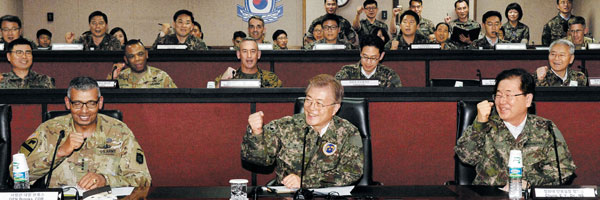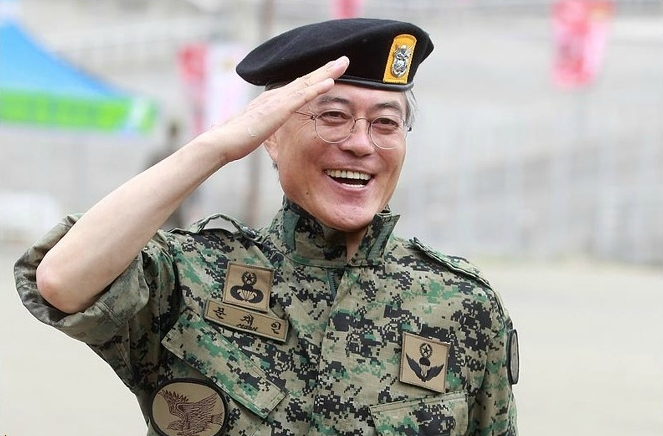President Moon favors increased ROK-US military cooperation to cope with Kim Jong Un
Who said President Moon Jae-in of the Republic of Korea is not friendly with the United States Forces in Korea? This appears to be wholly untrue because President Moon is seeking increased military cooperation with the US as well as promotion of interaction and collaboration with the US in the economic, political and various other areas.
In the initial stage of his Presidency, Moon appeared somewhat ‘opaque’ in his view of North Korea and the security situation on the Korean peninsula.
It appears that President Moon had a considerable measure confidence in the possibility that Chairman Kim Jong Un of North Korea might have a similar view to his based on a belief that another Korean war would mean a genocide for the Korean diaspora and therefore Chairman Kim might not choose it as in the case of Moon himself.

Chairman Kim appears to like brinksmanship and appears to find it fun to go to extreme lengths.
On the other hand, however, many people suspect that Kim has a very cruel mind and has little sense of value of the life of people. They point out the death sentence given his own uncle, Chang Sung-taik poisoning to death his own half-brother Kim Jung-nam.
On Sept. 23, 2017, several B-1B Lancer bombers of the U.S. Air Force engaged in a demonstration flight over the international airspace in North Korea's east coast around midnight on Sept. 23. This was the first time since the Korean War that a U.S. bomber had flown over North Korea's east coast, and the latest flight had triggered concerns that it could suggest the possibility of independent military action by the US against North Korea. On the afternoon of Sept. 24, President Moon Jae-in convened an emergency meeting of the National Security Council (NSC) and discussed ways to ease the recent tensions on the Korean Peninsula.
On Sept. 9, 2017, North Korean Foreign Minister Ri Yong-ho complained that President Donald Trump of the United States had just literally declared a war on his country, and warned that it would step up its up military provocations.
Speaking to news reporters outside the Millennium Hilton New York One UN Plaza in New York that day, Ri claimed that recent actions by Trump were ‘declaration of war.’
Ri said, “This past weekend, Trump again declared war on us, saying that our government will not last long,” Ri said

“These words were uttered by the incumbent President of the US and therefore it is a clear declaration of war. The world must remember clearly that it was the US that first declared war on us, ” Ri said.
The North Korean foreign minister then stated, “We now have all the rights to exercise the rights to self-defense and whether the US or North Korea will survive it will be made clear when the time comes.”
The North Korean declaration came three days after the show of force on Sept. 4 by the US Air Force in the vanity of the DMZ. Although the maneuver did not involve South Korea’s military, South Korea’s Presidential Office of Cheong Wa Dae has since stated that concerned authorities in Seoul were closely informed.
On Sept. 4, North Korea also claimed that it had sent open letters to political parties and parliaments of unspecified number of countries to rally their support against the US.
In the letters, issued under the names of North Korea’s parliament and ruling party, North Korea accused the US of pushing the world into a nuclear war.
Pyongyang has been issuing increasingly provocative threats against the US.
In addressing the UN General Assembly earlier on Sept. 23, Ri blamed Trump for his earlier UN address in which he warned that North Korea would face destruction if it attacks the US or its allies.
In his address, Ri said that North Korea would take "merciless" actions at any sign of military aggression against the country or its leadership. Ri also told reporters that a hydrogen bomb test in the Pacific could be carried out.
On Sept. 23, 2017, US strategic bomber B-1B Lancer, known as the “Swan of Death,” left form the Anderson Air Force Base in Guam and conducted a military demonstration by flying into the international airspace over North Korea's east coast on Sept. 23 (local time).
However, it is not clear whether the ROK government willingly approved of the
strategic bomber's military demonstration north of the DMZ, since the act is extremely
provocative in nature. Unlike the military demonstration on September 18, when the B-1B,
known as the “swan of death” was escorted by the South Korean Air Force's F-15K fighter jets,
this time, Korean aircraft were not airborne. A senior Cheong Wa Dae official said: “We knew
beforehand the U.S. deployment of the strategic bombers and the reason our aircraft did not take off was because the operation took place outside of our airspace and waters. There was no need for us to go.

However, the latest measure by the U.S. military can also convey a message that the U.S. can
engage in independent military operations against North Korea, fueling concerns.
In his National Liberation Day speech, President Moon has emphasized that the US must discuss any military action that can affect the Korean Peninsula with the South Korean government whenever he had the chance.
This day, President Moon convened an emergency meeting of the National Security Council
without any prior notice. Cheong Wa Dae released the fact that the 2-hour- and-twenty- minute
meeting was held after it ended, and simply announced that they discussed further measures to stop additional provocations by the North amidst escalating tensions due to a series of
provocations by Pyongyang and did not respond to further questions by the press.
The seven NSC meetings that the president had convened so far were all held after specific
actions, such as nuclear tests or missile launches, by North Korea, except for the one session held during the Ulji exercise on August 21, so this day's meeting was unusual. Over the phone, a Cheong Wa Dae official said, We can clearly say that there are no signs of any specific provocations from the North yet.
Thus, the sudden NSC meeting appears to be related to the solo military demonstration in the
airspace north of the Military Demarcation Line by the U.S. amidst a harsh verbal battle between North Korean leader Kim Jong-un and U.S. President Trump.
One diplomatic and security expert said, If the latest action by the U.S. suggests that the U.S.
can engage in military activities on the Korean Peninsula alone, the South Korean government
must send a message that military operations without the consent of South Korea can severely
hurt the ROK-US alliance.
Earlier in July this year, President Moon Jae-in visited the ROK-US Combined Forces Command in Yongsan, Seoul, met with General Vincent K. Brooks, commanding general of the ROK-US Command, and declared: “We (Korea and the United States) go together!”
In a separate development on the same day, the Presidential Mansion of Cheong Wa Dae in Seoul announced the visit of President Moon to the US for a summit meeting with President Donald Trump.
This visit by President Moon to the United States was arranged at the invitation of President Trump. For two days, June 29 and 30, the two Presidents will have a series of official events, including a welcoming dinner, a summit and a joint press conference.
The two Presidents are expected to exchange ideas on the directions of cooperation to further develop the ROK-U.S. alliance, on joint measures for the fundamental resolution of the North Korean nuclear issue, on the realization of peace on the Korean Peninsula and on the enhancement of substantive economic cooperation and collaboration on the international stage.

During the upcoming visit, President Moon will also sit together with Vice President Mike Pence and other key figures in the U.S. Administration. In addition, the President is scheduled to take part in events to be arranged by the U.S. Congress, academia and the business community as well as a meeting with representatives of the Korean community. As of now, discussions between the two sides are underway to determine details.
President Moon’s visit to the United States this time is a significant opportunity to lay the foundation for further upgrading Korea-U.S. relations since the launch of new Administrations in both nations. In particular, it is highly meaningful that close and robust cooperation between the two nations is to be strengthened at a time when it is especially essential.
Through the visit, it is hoped that the two heads of state would not only be able to deepen trust and friendship but would also share a vision for further developing the Korea-U.S. alliance into an even greater one and solidifying the basis of inclusive bilateral cooperation, including resolutely working together in response to North Korea.

